There are only an estimated 409 North Atlantic right whales left. They have been under attack by humans for far too long and must be protected. Please join us in defending these whales from further harm.
Don't wanna be here? Send us removal request.
Text
Ways to Help Protect North Atlantic Right Whales
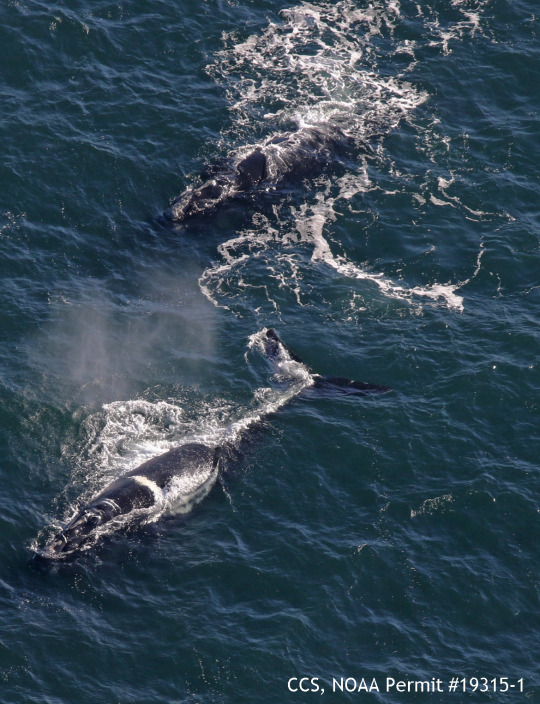
North Atlantic right whale #2910, a male first seen in 1999, (top), swims with Ruffian (#3530), a 15 year old male, in Cape Cod Bay on December 19, 2018. #2910 has been entangled in fishing ropes at least once before and Ruffian has been through two bad entanglements, the first of which happened when he was only about four years old and left him with significant scarring on the top of his head, his back and his flukes. He was freed from snow crab trap ropes and a large snow crab trap off the coast of Georgia in 2017 that he had been forced to carry all the way from Canada. credit: Center for Coastal Studies, permit #19315-1
1. The lobster and crab industries are responsible for a majority of North Atlantic right whale deaths. We go into much more detail on this in our Entanglement in Fishing Gear page but the fact is, these industries are driving North Atlantic right whales towards extinction and causing massive suffering along the way. We recommend avoiding anything caught in traps or gillnets to avoid contributing to the deaths of these whales. We must decide as a nation whether consuming fish and crustaceans is worth the suffering and possible extinction of these whales as it has unfortunately become clear that the industry is not changing their practices to help these whales. When we stop eating these foods we can feel good knowing that we are no longer supporting an industry that is violating the Endangered Species Act by killing these whales. 2. If you are piloting a boat remember that it is illegal to be within 1,500 feet of North Atlantic right whales. If you find yourself within the zone, depart immediately at a safe, slow speed. We recommend avoiding as many trips on boats as you can, whether it be personal watercraft or cruise ships. The large amount of ships in the ocean not only kill and injure whales by colliding with them, they also create noise pollution. The oceans are quite literally too loud for whales to be able to properly communicate with each other. 3. When it comes to making decisions on purchases we recommend trying to buy locally-made, or at least American-made products, so that they don’t have to be brought in on a container ship. The continued use of these cargo ships risks more ship strikes that kill and injure North Atlantic right whales and all other species of whales that inhabit the ocean. In one study of whale deaths around the world, researchers discovered that ships 80 meters or longer were responsible for more deaths than any other type of ship. 4. Avoid single-use plastic as much as possible and join (or conduct your own!) beach cleanups around you whenever you can. A full clean-up is ideal but if you can only grab a few things while you’re there here’s a few key things to pick up: plastic bags, rope and netting and anything with a loop on it (shipping straps, plastic 6-pack rings, etc.). Plastic bags look like jellyfish when they’re in the water so they are a particularly bad thing for any species that eats jellyfish including sperm whales and sea turtles. The rope, netting and any items with an enclosed loop such as six-pack rings are ingestion hazards and they could entangle sea life as well so removing these and cutting them up before properly disposing of them is crucial. 5. Don’t flush tampon applicators, q-tip sticks or any sort of plastic in toilets. These items float to the surface during sewage treatment and even though sewage treatment has improved over the years, lots of plastic doesn’t get filtered out and ends up in the ocean. Ingestion of plastics has been documented in at least 56% of cetacean species, with rates of ingestion as high as 31% in some populations. Plastic never truly biodegrades and is a major problem in the oceans. In 1985, it was estimated to kill up to 100,000 marine mammals every year and plastic pollution in the oceans has significantly increased since then. The full impact is currently unknown as many deaths from plastic pollution happen out at sea so it’s most likely even worse than we know. 6. Reducing our consumption of fossil fuels is another important action you can take to help these whales. Oil tankers strike whales and the burning of fossil fuels emits greenhouse gases that contribute to rapid warming of North Atlantic right whale habitat. One of the worst threats from these industries is the seismic blasting that’s used to find pockets of oil and gas. It’s devastating to marine life and increased levels of underwater noise have been shown to cause high levels of stress in North Atlantic right whales. There are many things you can do to make your home energy efficient during warmer months and in cooler months so we can reduce our dependence on fossil fuels. There are also key things you can do to reduce the energy usage of electronics in your home or office. Switching to LED light bulbs and purchasing Energy Star-rated appliances are also important ways to reduce energy usage. And, when it comes to your car, there are many things you can do to increase fuel efficiency. 7. When it comes to lawn care, natural is the way to go. Pesticides and fertilizers are unnecessary and should be avoided. Pesticides are toxic to sea life and fertilizers cause severe damage when rain washes them into waterways and storm drains that carry them out to the ocean. The NOAA’s 5-year review of North Atlantic right whales released in 2017 stated, “There is evidence that some contaminants, particularly those in flame retardants (polybrominated diphenyl ethers), detergents and pesticides (alkylphenol ethoxylates), disrupt endocrine pathways and reproduction in animals.” The report also noted that a 2010 study “analyzed blubber samples taken from five North Atlantic right whales that stranded along the eastern U.S. and Canada, and detected the presence of organochlorines, PCB’s, and brominated flame retardants in all five samples.” 8. In addition to avoiding pesticides and fertilizers, it’s best to avoid as many man-made chemicals as possible such as flame retardants, harmful cleaners that don’t properly break down and as many pharmaceuticals as possible. Many chemicals don’t get properly filtered out during sewage treatment and end up in lakes and the oceans when the effluent is pumped out of the treatment center. Phosphates, which are in many cleaning supplies, encourage plant growth which use up the oxygen marine life needs. They have been banned or reduced in at least 16 states but are still legal in a majority of states. Unfortunately, just because a product is legal in some areas doesn’t mean it’s safe. Many chemicals, such as PCB’s, have been banned later on after they were found to have been dangerous but should have been banned much sooner. The long term effects of many chemicals, and the effect of chemicals combining with others (the synergistic effect) is currently unknown. It’s better for our health and the health of all the species that inhabit the oceans to use natural cleaning products that don’t contain harmful chemicals. 9. When new regulations need public comments, new legislation needs notes of support (or opposition) or petitions need signatures we will send out the word a few different ways. We are on Facebook and Tumblr. And, if you haven’t read our Facts page yet we recommend checking that out as well. We talk about some of the things listed above with more depth, context and information so you can find out the details about what these whales are up against and how you can help them.
10. Remember that the law that bans approaching a North Atlantic right whale within 1,500 feet also applies to paddle-boarders, kayakers, swimmers, light aircraft and drone pilots (even those with FAA licenses). A special research permit from NOAA is required to be within 1,500 feet of these whales, for their own protection (and yours as getting near them can be incredibly dangerous). No one, including the writers of the actions listed above, is immune from mistakes but if we change now and get into good habits regarding these things then we can give these whales a fighting chance. Our actions are hurting these whales but it doesn’t have to be that way, the change can start with us, right here and right now. These whales need as much support as they can get so we thank you for looking for ways to take action!
43 notes
·
View notes
Photo
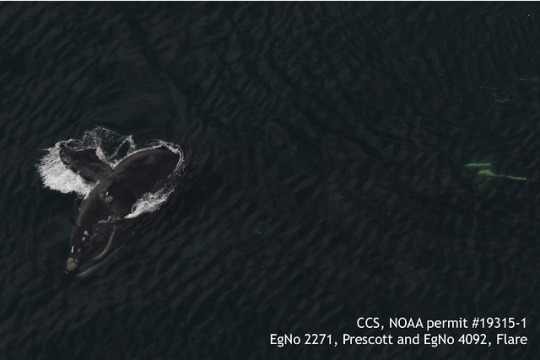
North Atlantic right whale Prescott (#2271), a 27 year old male, brings the side of his head out of the water and slaps his right flipper on the surface of Cape Cod Bay on March 13, 2019. To his right, Flare (#4092) - a female first seen in 2010 - swims just under the surface, the fishing rope entanglement scars at the base of her flukes making her visible to the aerial survey team.
credit: Center for Coastal Studies, NOAA permit #19315-1
25 notes
·
View notes
Photo

North Atlantic right whale Prescott (#2271), a 27 year old male, brings the side of his head out of the water and slaps his right flipper on the surface of Cape Cod Bay on March 13, 2019. To his right, Flare (#4092) - a female first seen in 2010 - swims just under the surface, the fishing rope entanglement scars at the base of her flukes making her visible to the aerial survey team.
credit: Center for Coastal Studies, NOAA permit #19315-1
#whales#right whales#North Atlantic right whales#narw 2271#narw 4092#cape cod bay#cape cod#massachusetts#atlantic ocean#oceans#endangered species#protect right whales
25 notes
·
View notes
Photo
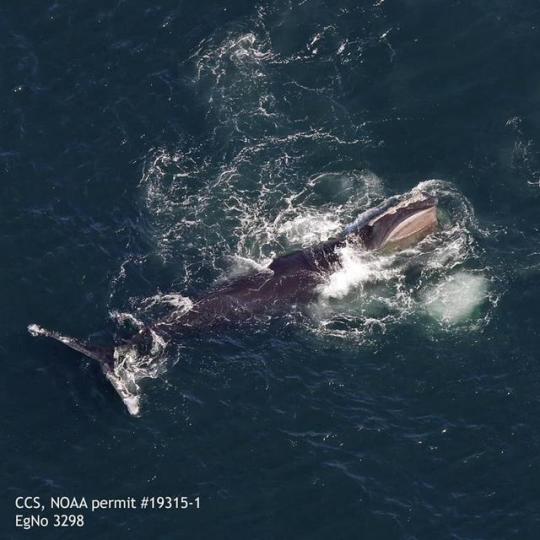
North Atlantic right whale #3298, a male who is at least 17 years old, feeds in Cape Cod Bay on March 9, 2019. #3298 is a regular visitor to Cape Cod Bay and the Great South Channel off the coast of New England.
credit: Center for Coastal Studies, NOAA permit #19315-1
36 notes
·
View notes
Photo
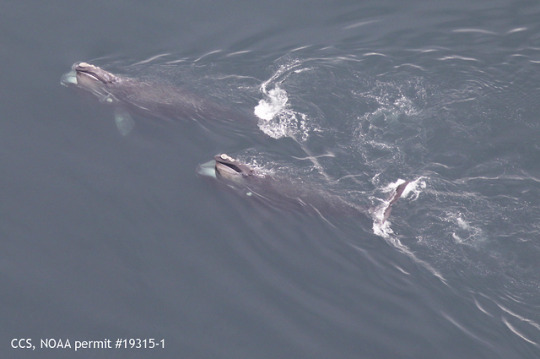
North Atlantic right whale #4191, top, feeds with #4520 in Cape Cod Bay on May 1, 2019. They are both young female right whales, #4191 is eight years old and #4520 is just four years old. They were seen following each other around as they were feeding on the same patch of food and were just two of many young right whales sighted that day.
credit: Center for Coastal Studies, NOAA permit #19315-1
#whales#right whales#North Atlantic right whales#narw 4191#narw 4520#cape cod bay#cape cod#massachusetts#atlantic ocean#oceans#endangered species#protect right whales
27 notes
·
View notes
Photo

North Atlantic right whale #3680 - a 15 year old male named Seadragon, left, and #1719 - a female of unknown age first seen in 1987, right, play at the surface in Cape Cod Bay on April 7, 2019.
credit: Center for Coastal Studies, NOAA permit #19315-1
#whales#right whales#North Atlantic right whales#narw 3680#narw 1719#cape cod bay#cape cod#massachusetts#atlantic ocean#oceans#endangered species#protect right whales
22 notes
·
View notes
Photo
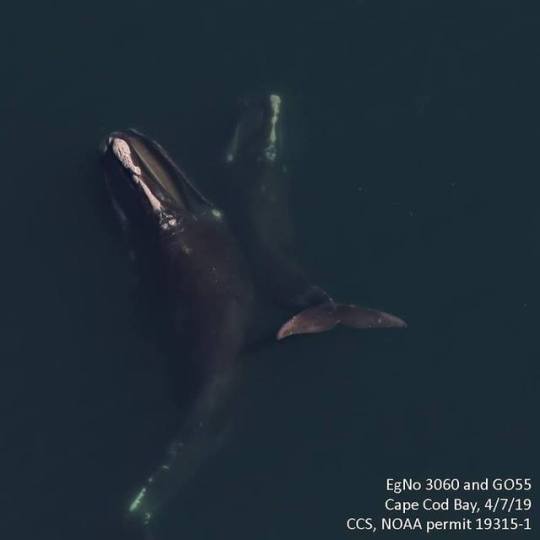
North Atlantic right whale #3060, a 20 year old male, left, subsurface feeding next to G055 in Cape Cod Bay on April 7, 2019. A non-four digit code like G055 is given when a whale is seen more than once but is unable to be matched to a cataloged whale. The Center for Coastal Studies notes that usually it is a young whale who has not been assigned a four digit ID yet. It will be very interesting to find out more about G055 such as how old they are, what their sex is and who their mother is.
credit: Center for Coastal Studies, NOAA permit #19315-1
#whales#right whales#North Atlantic right whales#narw 3060#narw g055#cape cod bay#cape cod#massachusetts#atlantic ocean#oceans#endangered species#protect right whales
38 notes
·
View notes
Text
Two North Atlantic Right Whale Calves Sighted in Cape Cod Bay

North Atlantic right whale #4180 swims with her calf in the southern portion of Cape Cod Bay on April 11, 2019. #4180 is at least nine years old and this is her first calf - she is the only first-time mother among the seven females that have given birth this year. credit: Center for Coastal Studies, NOAA permit #19315-1
Two of the seven North Atlantic right whale calves born this season were seen with their mothers by the Center for Coastal Studies aerial survey team in Cape Cod Bay on April 11th. We reported earlier this month that #1204 was seen in the bay with her new calf on April 7th, making us hopeful that we'll see the other four calves soon.
All three of the mother/calf pairs recently sighted in the bay were seen earlier this year in the southeastern US and have now successfully made the long and dangerous journey north through shipping lanes where ships constantly violate the voluntary speed restrictions and they are also forced to swim through areas that have no restrictions at all. They also have to avoid hundreds of thousands of fishing ropes that create a minefield of entanglement hazards and a increasing amount of plastic pollution in the Atlantic Ocean and in Cape Cod Bay itself. #4180 is at least 9 years old as she was first sighted in 2010 and this is her first calf. Her calf was the fifth one sighted this year and was first seen by a park ranger from the shore of Sebastian Inlet State Park in Sebastian, Florida on February 5th. Until her calf was seen, the sex of #4180 was unknown but now it's clear that she's a female which is excellent news as there are only around 100 females of breeding age in the population. Protecting females of breeding age is crucial to the survival of the population so it's wonderful to be able to add to that number. She is also the only first-time mother among the seven that have given birth this year. She has been seen in Cape Cod Bay every year except 2015 and she was most recently sighted there in late April of 2018. Researchers now realize she was pregnant at the time of that sighting. She was then seen in the Gulf of St. Lawrence in August of 2018 with nasty scars at the base of her flukes and on her back from an entanglement in fishing ropes that she experienced somewhere between Cape Cod Bay and the Gulf of St. Lawrence. She managed to free herself of the rope before she was sighted so researchers were unable to recover it or identify the origin of the rope. There is a significant amount of rope in the water between Massachusetts and Maine during that time that she could have become entangled in and it's also very possible she became entangled in the Gulf of St. Lawrence, an area that has become very popular among right whales - most likely due to shifting food supplies. At least four North Atlantic right whales have been killed by entanglements in snow crab trap ropes traced to the Gulf of St. Lawrence since 2016 (one in 2016, two in 2017 and one in 2018), at least six others have been entangled and some of them have not been seen since. There have also been other entangled right whales sighted in Canadian waters with the exact type and origin of the trap ropes being unknown. In 2018, there were at least three deaths of North Atlantic right whales - all from entanglements in fishing rope. The first death was traced to the Canadian snow crab fishery as the rope was still wrapped around the whale and could be traced to the source.[.pdf] The other two whales, the first of which was found near Martha's Vineyard in August of 2018 and the second who was found off Nantucket in October of 2018 both had wounds consistent with entanglements but unfortunately no rope was found on them that could be traced to a specific fishery and their identities are unknown. Many entanglements and deaths go unseen and many times, even if a death is seen, the whale is too decomposed or the rope has come off to do a more complete investigation or to even identity the individual whale. The first North Atlantic right whale found dead in 2018 was #3893 - she was only 10 years old when she was killed. When she was only three years old she was entangled in gillnet float line but was partially freed by rescuers and shed the rest of the line on her own. Her brother was killed by a fishing rope entanglement in 2012 when he was only a year old while her mother, Porcia (#3293), and her father, #1207, have both been entangled in ropes at least once and #1207 was struck and killed by a ship in the Gulf of St. Lawrence in 2017. His necropsy was held about a month before the last sighting of his daughter before she was found dead off the coast of Virginia. The entanglement of #4180 while she was pregnant shows just how close she came to not only being killed but also how close to death her unborn calf was and how there would be no chance for #4180 or her calf to contribute to the highly endangered population in the future. Seeing the horrible story of #3893, who was about the same age as #4180 and just entering her reproductive years when she was taken from this world by humans - and knowing that #4180 was entangled while she was pregnant with her first calf - underscores how serious the threats to these whales are and that the entanglements have to stop. Humans have tried to kill #4180 at least twice and she may not be so lucky the next time. This is why we all must continue to defend North Atlantic right whales and make sure they're truly protected. Our government is abdicating its responsibility to protect them so now it's up to the rest of us. The pain and suffering, the deaths, the loss of future life that these North Atlantic right whales could have brought into the world - it must end. Our Entanglement section has even more information on fishing rope entanglements and what we can all do to stop them from happening. #3317 and her calf were also sighted in Cape Cod Bay on April 11th. #3317 is 16 years old and was born in late 2002 to Silt (#1817), who was actually sighted in the bay four days earlier on April 7th, putting three generations in Cape Cod Bay on nearly the same day. Silt brought #3317 to Cape Cod Bay when she was a calf in 2003 but the Center for Coastal Studies didn’t see #3317 there again until 2016 when she brought her second calf there. She gave birth to her first calf in 2009, #3917, and even though they never saw #3317 bring her to Cape Cod Bay, #3917 has been observed there nearly every year since 2011 and was seen there this year. Last year (when #3317 she was pregnant) she was seen inside the bay between February and March. She was the second mom documented this season and was first documented with her calf from a shore sighting on January 13th off Ponte Vedra Beach, Florida. #3317 has been entangled in fishing rope at least once and also has propeller scars on her back from a boat strike. Four of the seven North Atlantic right whales that gave birth this year (#2791, #3317, Pico (#3270) and #4180) have entanglement scars. Pico and #4180 have been entangled at least twice, #3317 has been struck by a boat at least once and another mother that gave birth this year, #1204, also has possible entanglement and boat strike scars. These whales are under attack and while it's incredible that they were able to overcome all this and still give birth, which is truly a testament to their resilience, so many whales simply can't make it through and it's humans that are the problem.

North Atlantic right whale #3317 swims with her calf in the middle area of Cape Cod Bay on April 11, 2019. credit: Center for Coastal Studies, NOAA permit #19315-1
As we wrote in our post on April 15th about the recent sightings in Cape Cod Bay, there is currently a lobster trap ban in the bay but it's only seasonal as it ends on April 30th. There is also a 10 knot speed restriction in place for all vessels in Cape Cod Bay (a federal restriction on vessels over 65 feet and a state restriction on vessels under 65 feet) but these restrictions will also end on April 30th unless they get extended. Thankfully it is currently safer than many areas throughout their range as similar protections do not even exist in many other areas they are seen in but even with these protections these whales still face threats from ship traffic and marine debris in Cape Cod Bay during this time. Protective measures must be expanded and made permanent throughout their range to to make sure they're truly safe. It is also illegal to approach a North Atlantic right whale within 500 yards (1,500 feet) without a federal research permit. This includes boaters, kayakers, paddle-boarders, swimmers, light aircraft and drone pilots. However, as the Center for Coastal Studies states, "the right whales often feed very close to shore, offering whale watchers on land unbeatable views" of North Atlantic right whales. More Information: Large Numbers of North Atlantic Right Whales Sighted in Cape Cod Bay - 4/15/2019 Dozens of North Atlantic Right Whales Sighted in Cape Cod Bay - 3/19/2019 Mandatory Speed Limits in Effect for Cape Cod Bay - 1/2/2019 To find out more about what is happening to North Atlantic and North Pacific right whales and how we can all take actions in our everyday lives to protect them, please visit our Facts and Action sections on our website. We also post updates and pictures on Facebook, Tumblr and Twitter.
article: http://www.protectrightwhales.com/2019/4_22_cape_cod_bay_calves
#whales#right whales#North Atlantic right whales#narw 4180#2019 calf of narw 4180#narw 3317#2019 calf of narw 3317#cape cod bay#cape cod#massachusetts#atlantic ocean#oceans#endangered species#protect right whales
37 notes
·
View notes
Photo
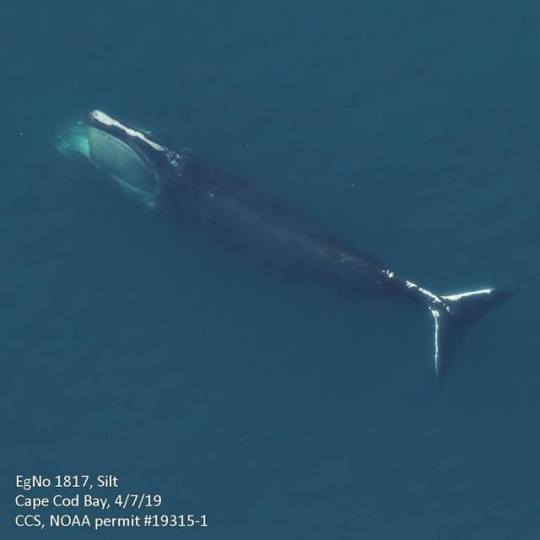
North Atlantic right whale Silt (#1817) feeds in Cape Cod Bay on April 7th, 2019. Silt gave birth in 2002 to #3317 who was recently sighted in the bay with her new calf on April 11th. Silt had taken #3317 to Cape Cod Bay when she was a calf in 2003 and now #3317 is doing the same with her calf, putting three generations in Cape Cod Bay at the same time. Extensive scarring from an entanglement in fishing rope can be seen at the base of Silt’s flukes.
credit: Center for Coastal Studies, NOAA permit #19315-1
51 notes
·
View notes
Photo

North Atlantic right whale Silt (#1817) feeds in Cape Cod Bay on April 7th, 2019. Silt gave birth in 2002 to #3317 who was recently sighted in the bay with her new calf on April 11th. Silt had taken #3317 to Cape Cod Bay when she was a calf in 2003 and now #3317 is doing the same with her calf, putting three generations in Cape Cod Bay at the same time. Extensive scarring from an entanglement in fishing rope can be seen at the base of Silt’s flukes.
credit: Center for Coastal Studies, NOAA permit #19315-1
#whales#right whales#North Atlantic right whales#narw 1817#cape cod bay#cape cod#massachusetts#atlantic ocean#oceans#endangered species#protect right whales
51 notes
·
View notes
Photo
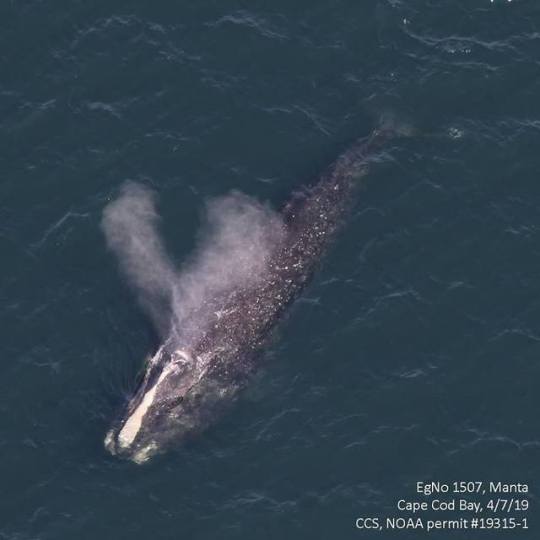
North Atlantic right whale Manta (#1507), a 34 year old male, swims in Cape Cod Bay on April 7, 2019. Manta was born in 1985 to Shenandoah (#1266) and is regularly seen in Cape Cod Bay, the Gulf of Maine and the Bay of Fundy off the coast of Nova Scotia.
credit: Center for Coastal Studies, NOAA permit #19315-1
#whales#right whales#North Atlantic right whales#narw 1507#cape cod bay#cape cod#massachusetts#gulf of maine#maine#bay of fundy#nova scotia#atlantic ocean#oceans#endangered species#protect right whales
19 notes
·
View notes
Photo

North Atlantic right whale #3298, a male who is at least 17 years old, feeds in Cape Cod Bay on March 9, 2019. #3298 is a regular visitor to Cape Cod Bay and the Great South Channel off the coast of New England.
credit: Center for Coastal Studies, NOAA permit #19315-1
#whales#right whales#North Atlantic right whales#narw 3298#cape cod bay#cape cod#massachusetts#great south channel#new england#atlantic ocean#oceans#endangered species#protect right whales
36 notes
·
View notes
Text
Ways to Help Protect North Atlantic Right Whales

North Atlantic right whale #2910, a male first seen in 1999, (top), swims with Ruffian (#3530), a 15 year old male, in Cape Cod Bay on December 19, 2018. #2910 has been entangled in fishing ropes at least once before and Ruffian has been through two bad entanglements, the first of which happened when he was only about four years old and left him with significant scarring on the top of his head, his back and his flukes. He was freed from snow crab trap ropes and a large snow crab trap off the coast of Georgia in 2017 that he had been forced to carry all the way from Canada. credit: Center for Coastal Studies, permit #19315-1
1. The lobster and crab industries are responsible for a majority of North Atlantic right whale deaths. We go into much more detail on this in our Entanglement in Fishing Gear page but the fact is, these industries are driving North Atlantic right whales towards extinction and causing massive suffering along the way. We recommend avoiding anything caught in traps or gillnets to avoid contributing to the deaths of these whales. We must decide as a nation whether consuming fish and crustaceans is worth the suffering and possible extinction of these whales as it has unfortunately become clear that the industry is not changing their practices to help these whales. When we stop eating these foods we can feel good knowing that we are no longer supporting an industry that is violating the Endangered Species Act by killing these whales. 2. If you are piloting a boat remember that it is illegal to be within 1,500 feet of North Atlantic right whales. If you find yourself within the zone, depart immediately at a safe, slow speed. We recommend avoiding as many trips on boats as you can, whether it be personal watercraft or cruise ships. The large amount of ships in the ocean not only kill and injure whales by colliding with them, they also create noise pollution. The oceans are quite literally too loud for whales to be able to properly communicate with each other. 3. When it comes to making decisions on purchases we recommend trying to buy locally-made, or at least American-made products, so that they don’t have to be brought in on a container ship. The continued use of these cargo ships risks more ship strikes that kill and injure North Atlantic right whales and all other species of whales that inhabit the ocean. In one study of whale deaths around the world, researchers discovered that ships 80 meters or longer were responsible for more deaths than any other type of ship. 4. Avoid single-use plastic as much as possible and join (or conduct your own!) beach cleanups around you whenever you can. A full clean-up is ideal but if you can only grab a few things while you’re there here’s a few key things to pick up: plastic bags, rope and netting and anything with a loop on it (shipping straps, plastic 6-pack rings, etc.). Plastic bags look like jellyfish when they’re in the water so they are a particularly bad thing for any species that eats jellyfish including sperm whales and sea turtles. The rope, netting and any items with an enclosed loop such as six-pack rings are ingestion hazards and they could entangle sea life as well so removing these and cutting them up before properly disposing of them is crucial. 5. Don’t flush tampon applicators, q-tip sticks or any sort of plastic in toilets. These items float to the surface during sewage treatment and even though sewage treatment has improved over the years, lots of plastic doesn’t get filtered out and ends up in the ocean. Ingestion of plastics has been documented in at least 56% of cetacean species, with rates of ingestion as high as 31% in some populations. Plastic never truly biodegrades and is a major problem in the oceans. In 1985, it was estimated to kill up to 100,000 marine mammals every year and plastic pollution in the oceans has significantly increased since then. The full impact is currently unknown as many deaths from plastic pollution happen out at sea so it’s most likely even worse than we know. 6. Reducing our consumption of fossil fuels is another important action you can take to help these whales. Oil tankers strike whales and the burning of fossil fuels emits greenhouse gases that contribute to rapid warming of North Atlantic right whale habitat. One of the worst threats from these industries is the seismic blasting that’s used to find pockets of oil and gas. It’s devastating to marine life and increased levels of underwater noise have been shown to cause high levels of stress in North Atlantic right whales. There are many things you can do to make your home energy efficient during warmer months and in cooler months so we can reduce our dependence on fossil fuels. There are also key things you can do to reduce the energy usage of electronics in your home or office. Switching to LED light bulbs and purchasing Energy Star-rated appliances are also important ways to reduce energy usage. And, when it comes to your car, there are many things you can do to increase fuel efficiency. 7. When it comes to lawn care, natural is the way to go. Pesticides and fertilizers are unnecessary and should be avoided. Pesticides are toxic to sea life and fertilizers cause severe damage when rain washes them into waterways and storm drains that carry them out to the ocean. The NOAA’s 5-year review of North Atlantic right whales released in 2017 stated, “There is evidence that some contaminants, particularly those in flame retardants (polybrominated diphenyl ethers), detergents and pesticides (alkylphenol ethoxylates), disrupt endocrine pathways and reproduction in animals.” The report also noted that a 2010 study “analyzed blubber samples taken from five North Atlantic right whales that stranded along the eastern U.S. and Canada, and detected the presence of organochlorines, PCB’s, and brominated flame retardants in all five samples.” 8. In addition to avoiding pesticides and fertilizers, it’s best to avoid as many man-made chemicals as possible such as flame retardants, harmful cleaners that don’t properly break down and as many pharmaceuticals as possible. Many chemicals don’t get properly filtered out during sewage treatment and end up in lakes and the oceans when the effluent is pumped out of the treatment center. Phosphates, which are in many cleaning supplies, encourage plant growth which use up the oxygen marine life needs. They have been banned or reduced in at least 16 states but are still legal in a majority of states. Unfortunately, just because a product is legal in some areas doesn’t mean it’s safe. Many chemicals, such as PCB’s, have been banned later on after they were found to have been dangerous but should have been banned much sooner. The long term effects of many chemicals, and the effect of chemicals combining with others (the synergistic effect) is currently unknown. It’s better for our health and the health of all the species that inhabit the oceans to use natural cleaning products that don’t contain harmful chemicals. 9. When new regulations need public comments, new legislation needs notes of support (or opposition) or petitions need signatures we will send out the word a few different ways. We are on Facebook and Tumblr. And, if you haven’t read our Facts page yet we recommend checking that out as well. We talk about some of the things listed above with more depth, context and information so you can find out the details about what these whales are up against and how you can help them.
10. Remember that the law that bans approaching a North Atlantic right whale within 1,500 feet also applies to paddle-boarders, kayakers, swimmers, light aircraft and drone pilots (even those with FAA licenses). A special research permit from NOAA is required to be within 1,500 feet of these whales, for their own protection (and yours as getting near them can be incredibly dangerous). No one, including the writers of the actions listed above, is immune from mistakes but if we change now and get into good habits regarding these things then we can give these whales a fighting chance. Our actions are hurting these whales but it doesn’t have to be that way, the change can start with us, right here and right now. These whales need as much support as they can get so we thank you for looking for ways to take action!
#whales#right whales#North Atlantic right whales#atlantic ocean#oceans#endangered species#protect right whales
43 notes
·
View notes
Text
Large Numbers of North Atlantic Right Whales Sighted in Cape Cod Bay
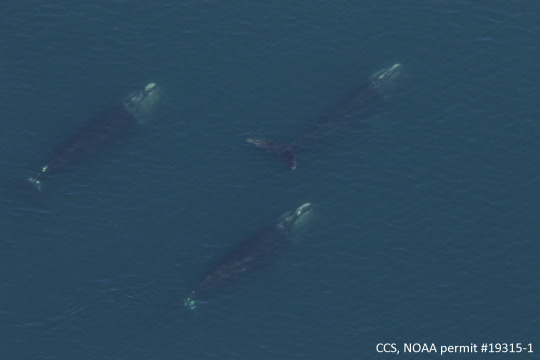
Three North Atlantic right whales - #1719, left, Seadragon (#3680), bottom, and Haley (#2750), top right, feed together in Cape Cod Bay on April 7, 2019. All three have scars at the base of their flukes from previous entanglements in fishing ropes. credit: Center for Coastal Studies, NOAA permit #19315-1
Large numbers of North Atlantic right whales have been sighted in Cape Cod Bay in recent weeks with 219 individual whales - over half of the population of only about 415 - sighted in the past four months. The Center for Coastal Studies reports that the highest number sighted in one day was 158 - more than 1/3 of the population. They also report that other cetacean species are arriving in the bay including humpback, fin, sei and minke whales. Sei whales, like North Atlantic right whales, are classified as Endangered and fin whales are classified as Vulnerable by the IUCN, further making the protection of Cape Cod Bay a top priority as the protections put in place to help North Atlantic right whales will help all other species of whales as well. Protective measures in Cape Cod Bay are especially important as two more calves were sighted with their mothers in the bay. #4180 and #3317 were sighted with their calves in the bay on April 11th and we reported last week that #1204 was seen in the bay with her new calf on April 7th. All three were seen earlier this year in the southeastern US with their calves and successfully made the long and dangerous journey north through shipping lanes where ships constantly violate the voluntary speed restrictions or go through areas that have no restrictions at all. They also have to avoid hundreds of thousands of fishing ropes that create a minefield of entanglement hazards and an increasing amount of marine debris.
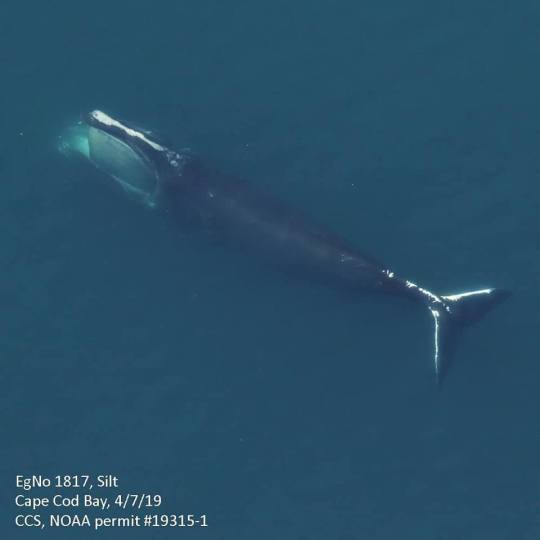
North Atlantic right whale Silt (#1817) feeds in Cape Cod Bay on April 7th, 2019. Silt gave birth in 2002 to #3317 who was just sighted in the bay with her new calf on April 11th. Silt had taken #3317 to Cape Cod Bay when she was a calf in 2003 and now #3317 is doing the same with her calf, putting three generations in Cape Cod Bay at the same time. Scars from an entanglement in fishing rope can be seen at the base of Silt's flukes. credit: Center for Coastal Studies, NOAA permit #19315-1
The population was estimated to be 411 in 2017 and with 3 known deaths in 2018 (and no births that year) and 7 calves born this year, the population is estimated to be no more than 415 - not including any whales that researchers believe have died since 2017 after not seeing them for a significant amount of time. It's also believed that as few as 1 in 3 deaths are actually seen. 83% of North Atlantic right whales have been entangled in rope at least once in their lives and entanglements have been the cause of 85% of deaths since 2010. Cape Cod Bay currently has a lobster trap ban but it's only seasonal as it ends on April 30th. There is also a 10 knot speed restriction in place for all vessels in Cape Cod Bay (a federal restriction on vessels over 65 feet and a state restriction on vessels under 65 feet) but these restrictions will end on April 30th as well unless they get extended. Thankfully it is currently safer than many areas throughout their range as similar protections do not even exist in many other areas they are seen in but even with these protections these whales still face threats from ship traffic and marine debris in Cape Cod Bay during this time. Protective measures must be expanded and made permanent throughout their range to to make sure they're truly safe. It is also illegal to approach a North Atlantic right whale within 500 yards (1,500 feet) without a federal research permit. This includes boaters, kayakers, paddle-boarders, swimmers, light aircraft and drone pilots. However, as the Center for Coastal Studies states, "the right whales often feed very close to shore, offering whale watchers on land unbeatable views" of North Atlantic right whales. Sources: First North Atlantic Right Whale Calf Sighting of 2019 in Cape Cod Bay - 4/10/2019 Dozens of North Atlantic Right Whales Sighted in Cape Cod Bay - 3/19/2019 Mandatory Speed Limits in Effect for Cape Cod Bay - 1/2/2019 To find out more about what is happening to North Atlantic and North Pacific right whales and how we can all take actions in our everyday lives to protect them, please visit our Facts and Action sections on our website. We also post updates and pictures on Facebook, Tumblr and Twitter.
article: http://www.protectrightwhales.com/2019/4_15_cape_cod_bay_sightings
#whales#right whales#North Atlantic right whales#narw 1719#narw 3680#narw 2750#narw 1817#cape cod bay#cape cod#massachusetts#atlantic ocean#oceans#endangered species#protect right whales
34 notes
·
View notes
Text
First North Atlantic Right Whale Calf Sighting of 2019 in Cape Cod Bay
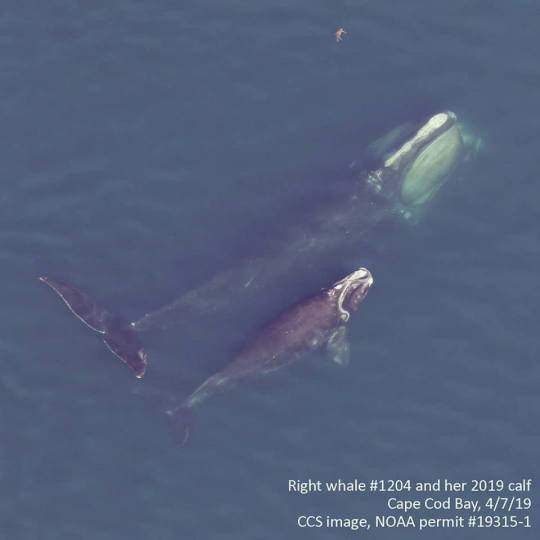
North Atlantic right whale #1204 swims with her calf in Cape Cod Bay on April 7, 2019 after making the long and dangerous journey north from the calving grounds in the southeastern US. credit: Center for Coastal Studies, permit #19315-1
The first sighting of a North Atlantic right whale calf in Cape Cod Bay this year occurred on April 7th. The calf and its mother, #1204, were sighted by the aerial survey team at the Center for Coastal Studies (CCS), making this the first calf sighting in the bay since 2017 as no calves were seen in 2018. This calf was first seen near Amelia Island, Florida on January 17th and is the third calf out of a total of only seven to be seen this year. #1204 was first seen in 1982 and is at least 38 years old, she last gave birth six years ago and is one of the most successful mothers in the population as this is her ninth calf (#1240 and #1334 have also had nine calves). She was sighted in Cape Cod Bay in April and May of 2018 and was most likely pregnant with her new calf at the time of those sightings. CCS reported in their post announcing the sighting that out of the nine calves she's had, this is only the second one that #1204 has been documented with in Cape Cod Bay. We wish #1204 and her calf the best as they swim and feed in Cape Cod Bay and hope to see the other calves and their mothers in the bay soon! There is currently a 10 knot speed restriction for all vessels in Cape Cod Bay (a federal restriction on vessels over 65 feet and a state restriction on vessels under 65 feet) along with a ban on lobster traps until April 30th. It is also illegal to approach a North Atlantic right whale within 1,500 feet without a federal research permit. This includes boaters, kayakers, paddle-boarders, swimmers, light aircraft and drone pilots. However, as CCS states, "the right whales often feed very close to shore, offering whale watchers on land unbeatable views" of North Atlantic right whales. Even with these protections - which are unfortunately only seasonal and are lifted at the end of April - these whales still face threats from ship traffic and marine debris in Cape Cod Bay during this time. Thankfully it is currently safer than many areas North Atlantic right whales visit but the battle goes on to make sure they're truly safe.
More Information: MarineFisheries Advisory - Seasonal Small Vessel Speed Limit in Cape Cod Bay - [.pdf] - 3/8/2019 Third North Atlantic Right Whale Calf of 2018-2019 Calving Season Sighted Off Florida - 1/25/2019 Mandatory Speed Limits in Effect for Cape Cod Bay - 1/2/2019 To find out more about what is happening to North Atlantic and North Pacific right whales and how we can all take actions in our everyday lives to protect them, please visit our Facts and Action sections on our website. We also post updates and pictures on Facebook, Tumblr and Twitter.
article: http://www.protectrightwhales.com/2019/4_10_first_cape_cod_bay_calf
#whales#right whales#North Atlantic right whales#narw 1204#2019 calf of narw 1204#cape cod bay#cape cod#massachusetts#atlantic ocean#oceans#endangered species#protect right whales
69 notes
·
View notes
Photo
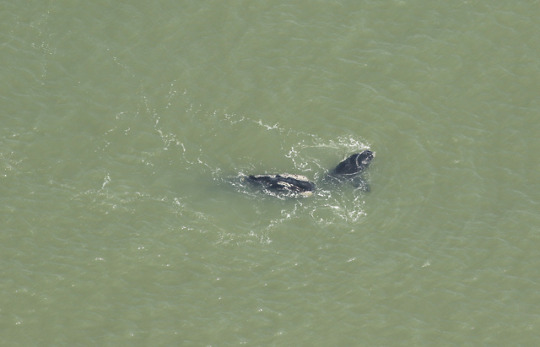
North Atlantic right whale #3370 and her calf swim about half a nautical mile off Palm Coast, Florida on March 21, 2019. #3370 is at least 16 years old and this is her second calf - one of only seven to be born this year. The calf is partially rolled, showing its entire right lip. We hope the calf and their mother are having a safe trip north and look forward to hopefully seeing photographs of them in Cape Cod Bay soon.
credit: Florida Fish and Wildlife Conservation Commission, taken under NOAA permit #20556-01
#whales#right whales#North Atlantic right whales#narw 3370#2019 calf of narw 3370#palm coast#florida#atlantic ocean#oceans#endangered species#protect right whales
44 notes
·
View notes
Text
Atlantic Seismic Airgun Protection Act Reintroduced in 116th Congress
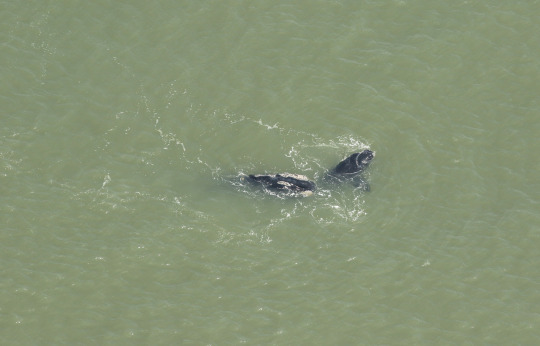
North Atlantic right whale #3370 swims with her calf about half a nautical mile from the shore of Palm Coast, Florida on March 21, 2019. The calf is partially rolled on its side, showing their entire right lip. #3370 is at least 16 years old and this is her second calf.
Mother/calf pairs are at the highest risk from seismic blasting as the stress levels and energy expended in trying to escape the blasting could affect reproduction and calves could become separated from their mothers because the calls they use to communicate could be drowned out by the blasting.
credit: Florida Fish and Wildlife Conservation Commission, permit #20556-01
The Atlantic Seismic Airgun Protection Act (H.R. 1606) has been reintroduced in the 116th Congress by Rep. Don Beyer (D-VA) and Rep. Chris Smith (R-NJ). The legislation would amend the Outer Continental Shelf Lands Act to prohibit oil, gas, and methane hydrate-related seismic activities in the North Atlantic, Mid-Atlantic, South Atlantic, and Straits of Florida planning areas of the outer Continental shelf. This is extremely important legislation that would protect highly endangered North Atlantic right whales - and all other life in the Atlantic Ocean - from the devastating effects of seismic blasting. There is also an urgent need to pass this legislation as soon as possible, considering that five permits for seismic blasting in the Atlantic were approved in December of 2018. The decision to allow seismic blasting violates three federal laws - the Endangered Species Act, Marine Mammal Protection Act and the National Environmental Policy Act - which led a large, diverse coalition of groups to file a lawsuit against the proposed blasting. A coalition of conservation organizations is also seeking a court order to put an immediate halt to the blasting while the lawsuit works its way through the courts. A more permanent solution is needed in the long-term though and that's what this legislation would provide. It's a simple bill that only comes in at two pages long but that's as long as it needs to be in order to ban seismic blasting. If this only two-page bill could be passed, North Atlantic right whales and the countless other species that call the Atlantic Ocean home would be safe from the devastating noise pollution and physical damage from seismic blasting - and from the drilling, extraction, transportation and burning of any oil that was found during the blasting. Rep. Don Beyer (D-VA) also participated in the hearing that was held by the Water, Oceans, and Wildlife Subcommittee of the Natural Resources Committee in the House that was held on March 7th. We wrote about Rep. Joe Cunningham (D-SC) using an air horn during the hearing to demonstrate noise pollution that would be caused by seismic blasting. Rep. Beyer begins his questioning at 1:29:41 in the video of the hearing. We fully endorse the Atlantic Seismic Airgun Protection Act (H.R. 1606) and believe it does have a chance of passing the House now. When the bill was introduced in 2017 during the 115th Congress it had 40 co-sponsors - 37 Democrats and 3 Republicans - one of the Republicans was Rep. Chris Smith (R-NJ) who is an original co-sponsor of the new bill and the other two Republicans lost their seats but to Democrats that are strongly opposed to seismic blasting (Rep. Jeff Van Drew (D-NJ) and Rep. Joe Cunningham). Of the 37 Democrats, most kept their seats and will most likely cosponsor the new bill while a few others left Congress but were replaced by Democrats that we believe will cosponsor or at least vote for the new bill as well. A companion bill, S. 828, was introduced in the Senate by Sen. Cory Booker (D-NJ) along with nine other Democrats and 1 Independent - Sen. Bernie Sanders (I-VT). Unfortunately, even if it passes the House, the Senate will most likely not hold a vote on S. 828 as the Senate Republicans are increasingly hostile to the Endangered Species Act - one of the major laws that protects North Atlantic right whales - and they are also very supportive of the oil and gas industries. Even if it somehow passed the Senate, it would not be signed into law because the President and his allies are the ones that want the oil drilling to occur. However, it's important for this legislation to be passed (something that was impossible in the previous Congress due to Republican control) in order to lay the groundwork for the ban to eventually be signed into law. More Information:
Congressman Blasts Air Horn During Hearing to Demonstrate Noise Pollution - 3/30/2019
Groups Seek Court Order to Block Seismic Blasting in Atlantic Ocean - 2/23/2019 Federal Judge Halts Offshore Oil Drilling Permits During Government Shutdown - 1/24/2019 Special Report: Trump Administration Approves Seismic Blasting in Atlantic Ocean - 12/8/2018 To find out more about what is happening to North Atlantic and North Pacific right whales and how we can all take actions in our everyday lives to protect them, please visit our Facts and Action sections on our website. We also post updates and pictures on Facebook, Tumblr and Twitter.
article: http://www.protectrightwhales.com/2019/4_9_atlantic_seismic_airgun_protection_act_reintroduced
#whales#right whales#North Atlantic right whales#atlantic seismic airgun protection act#hr 1606#congress#florida#georgia#south carolina#north carolina#virginia#maryland#delaware#new jersey#atlantic ocean#oceans#endangered species#seismic blasting#oil drilling#protect right whales
14 notes
·
View notes